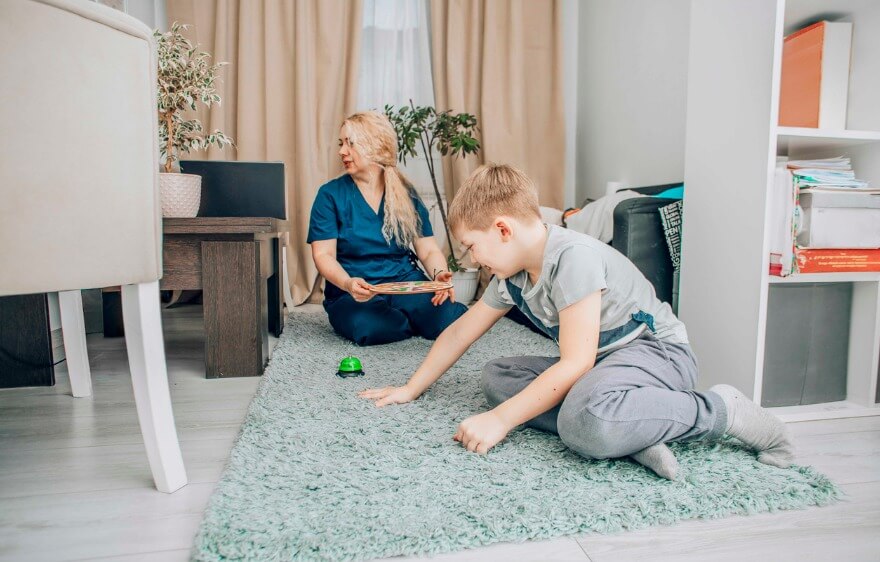Chances are good that you have students on your caseload who struggle with attention issues or have been diagnosed with ADHD. Speech and language disorders occur in up to 17-38% of individuals with ADHD.
What is ADHD?
ADHD – attention deficit hyperactivity disorder – is thought to be caused by developmental differences in the brain that affect the parts controlling attention, concentration, impulsivity, activity levels, and memory.
Children with ADHD often present very differently from one another. Some children with ADHD are hyperactive, while others are extremely impulsive. Some kids with ADHD lack the ability to focus, and some children with ADHD struggle with a combination of all three (hyperactivity, impulsivity, and focus). ADHD is the most commonly diagnosed mental disorder in children, and according to the American Psychiatric Association, 5% of American children have received an ADHD diagnosis.
7 Ways to Help a Child with ADHD
Many of the same behavioral issues that arise in the classroom for these students also make behavior management in the speech room challenging and can limit progress toward language goals.
If your child has ADHD, here are a few things (occupational therapist approved!) you can do at home to help your child.
1. Positive Reinforcement
Be quick to reward what they’re doing right instead of punishing what they’re doing wrong. Oftentimes, kids with ADHD are bombarded with negativity. Perhaps they struggle in school, in sports, or with friends. Make your home a safe space for them and fill it with an abundance of positivity.
Children with ADHD need oodles of praise, so consider rewarding your child for good behavior instead of scolding them for bad behavior.
2. Contracts
A written (and signed) document outlining in positive terms what you want the student to do and the rewards (and consequences) associated.
3. Token Program
The student receives a token, such as a star, sticker, or penny, immediately after demonstrating the desired behavior. Tokens are collected and later exchanged for a prize or privilege.
Take away previously earned ‘tokens’ or reinforcers, but make sure there are more opportunities for success than for failure!
4. Feed them Sensory Foods
Eating foods that require excessive amounts of chewing or sucking provide the mouth with a great workout, which is actually really soothing for a child with ADHD.
Luckily, most fruits and vegetables are crunchy – think carrots, celery, and apples – and are portable options you can take almost anywhere.
Other great snack options include chewy fruit leathers, hard pretzels, and, in a pinch, a piece of gum.
5. Redirection
Distract them from the inappropriate behavior and encourage them to focus on something that will help them behave correctly. Instead of punishing, give an opportunity for success!
6. Play Therapeutic Music or Meditations to Help Them Unwind
Much like music can affect the mood of an adult, it can make or break the mood of a small child, too.
Try searching for “soothing tunes” or “calming music” on the Spotify app, and choose songs that speak to you. Some of my favorites for calming my kids include acoustic guitar tunes, songs with deep earth drum sounds, and classical music by Chopin.
If music isn’t your thing, there are plenty of apps out there that provide guided meditations for children, such as Headspace and Slumber.
7. Create a Calming Environment
Children with ADHD struggle to unwind, so be cognizant of this and offer them a calm environment whenever you can.
For example, when your child gets home from a party, find a quiet place for him or her to have some quiet time and decompress. Some children need physical activity to unwind; sounds counterintuitive, right? However, expending energy actually feeds our bodies with calming input, which is crucial for kids with ADHD. Get active with your kids: go on a run, play some tennis, or join in a game of freeze tag in the backyard.
Also, think about your therapy space.
- Can you de-junk and un-clutter the space so it is more free from distraction?
- What kinds of structure, routine, and repetition can you provide?
Schedule Your Child’s Care Assessment Today
At Care Options for Kids, we understand the unique challenges of caring for a child with health conditions. Our dedicated team of pediatric home health nurses is here to support your family with compassionate, expert care tailored to your child’s needs. Contact us today to schedule an assessment and learn how we can help you navigate this journey with confidence and care.
Click here to start your journey to better care.
This post is for educational and informational purposes only. You should always speak with your own therapist before implementing this information on your own.






